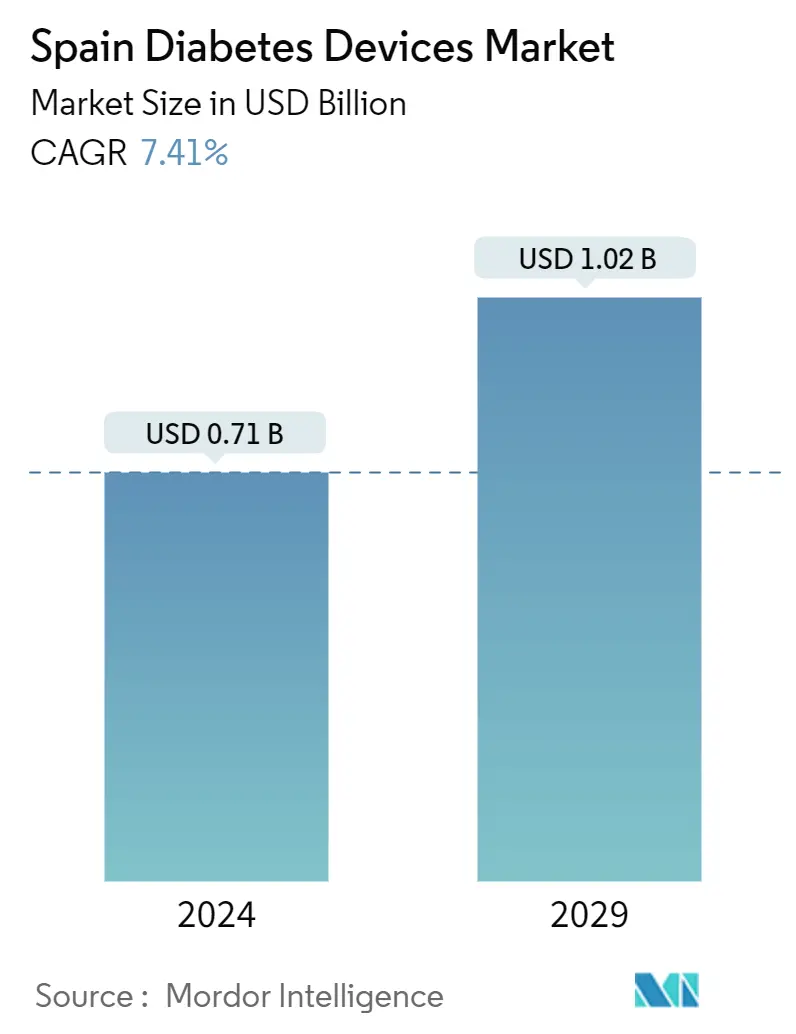Market Size of Spain Diabetes Devices Industry

| Study Period | 2019- 2029 |
| Base Year For Estimation | 2023 |
| Forecast Data Period | 2024 - 2029 |
| Market Size (2024) | USD 0.71 Billion |
| Market Size (2029) | USD 1.02 Billion |
| CAGR (2024 - 2029) | 7.41 % |
Major Players
*Disclaimer: Major Players sorted in no particular order |
Spain Diabetes Devices Market Analysis
The Spain Diabetes Devices Market size is estimated at USD 0.71 billion in 2024, and is expected to reach USD 1.02 billion by 2029, growing at a CAGR of 7.41% during the forecast period (2024-2029).
In Sapin According to WHO, as of 25 June 2022, a total of 102,258,825 vaccine doses have been administered. Regardless of previous diabetes history, admission hyperglycemia is a significant predictor of all-cause death in non-critically hospitalized COVID-19 patients. Spain was among the nations most severely impacted by the COVID-19 pandemic in 2020. A total countrywide lockdown was implemented from 14 March 2020 through 21 June 2020 to limit the epidemic due to an increase in instances.
The diabetes device market in Spain has witnessed significant growth in recent years, driven by the growing number of people living with diabetes. These devices play a crucial role in helping individuals monitor their blood glucose levels, administer insulin, and manage their overall health.
One of the key factors contributing to the rise in diabetes prevalence is the changing lifestyle and dietary habits of the Spanish population. The adoption of a more sedentary lifestyle, coupled with an increase in the consumption of processed foods and sugary beverages, has led to a higher incidence of obesity and type 2 diabetes.
Additionally, an aging population and genetic predisposition to diabetes have also contributed to the increasing prevalence of the disease. As the population ages, the risk of developing diabetes rises, further driving the demand for diabetes devices.
The Spanish government and healthcare organizations have recognized the urgency of addressing this issue and have implemented various initiatives to combat the rising prevalence of diabetes. These initiatives include awareness campaigns, educational programs, and improved access to diabetes management resources, including diabetes devices.
Critical elements of the therapy of type 1 diabetes include medical devices (T1D). Devices include insulin pumps, continuous glucose monitors (CGMs), and blood glucose meters. These gadgets are linked to better glucose management and decreased hypoglycemia.
Spain Diabetes Devices Industry Segmentation
The Spanish diabetes devices market is segmented by management devices (insulin pumps, insulin syringes, cartridges in reusable pens, insulin disposable pens, and jet injectors) and monitoring devices (self-monitoring blood glucose and continuous glucose monitoring). The report offers the value (in USD) and volume (in units) for the above segments.
| Monitoring Devices | |||||
| |||||
|
| Management Devices | |||||
| |||||
| Insulin Syringes | |||||
| Insulin Cartridges | |||||
| Disposable Pens |
Spain Diabetes Devices Market Size Summary
The diabetes devices market in Spain is experiencing significant expansion, driven by the increasing prevalence of diabetes among the population. This growth is largely attributed to lifestyle changes, such as a more sedentary way of living and a rise in the consumption of processed foods, which have contributed to higher rates of obesity and type 2 diabetes. Additionally, the aging population and genetic factors have further exacerbated the situation, leading to a greater demand for diabetes management devices. The Spanish government and healthcare organizations are actively addressing this public health challenge through various initiatives, including awareness campaigns and improved access to diabetes management resources. These efforts are crucial as diabetes devices, such as insulin pumps and continuous glucose monitors, play a vital role in helping individuals manage their condition effectively.
The market is also witnessing technological advancements and innovations, particularly in continuous glucose monitoring devices, which are becoming increasingly popular due to their enhanced accuracy and convenience. The rise in demand for these devices has prompted manufacturers to develop new and improved solutions, further fueling market growth. Spain's position as one of the top countries in terms of diabetes prevalence and healthcare expenditure underscores the urgency of addressing this health issue. The market's expansion is supported by strategic mergers and acquisitions, such as Dexcom's acquisition of TypeZero Technologies, which aim to advance automated insulin delivery systems. These developments highlight the dynamic nature of the diabetes devices market in Spain, as it continues to evolve in response to the growing need for effective diabetes management solutions.
Spain Diabetes Devices Market Size - Table of Contents
-
1. MARKET DYNAMICS
-
1.1 Market Overview
-
1.2 Market Drivers
-
1.3 Market Restraints
-
1.4 Industry Attractiveness - Porter's Five Forces Analysis
-
1.4.1 Bargaining Power of Buyers/Consumers
-
1.4.2 Bargaining Power of Suppliers
-
1.4.3 Threat of New Entrants
-
1.4.4 Threat of Substitute Products
-
1.4.5 Intensity of Competitive Rivalry
-
-
-
2. MARKET SEGMENTATION
-
2.1 Monitoring Devices
-
2.1.1 Self-monitoring Blood Glucose Devices
-
2.1.1.1 Glucometer Devices
-
2.1.1.2 Test Strips
-
2.1.1.3 Lancets
-
-
2.1.2 Continuous Blood Glucose Monitoring
-
2.1.2.1 Sensors
-
2.1.2.2 Durables
-
-
-
2.2 Management Devices
-
2.2.1 Insulin Pump
-
2.2.1.1 Insulin Pump Device
-
2.2.1.2 Insulin Pump Reservoir
-
2.2.1.3 Infusion Set
-
-
2.2.2 Insulin Syringes
-
2.2.3 Insulin Cartridges
-
2.2.4 Disposable Pens
-
-
Spain Diabetes Devices Market Size FAQs
How big is the Spain Diabetes Devices Market?
The Spain Diabetes Devices Market size is expected to reach USD 0.71 billion in 2024 and grow at a CAGR of 7.41% to reach USD 1.02 billion by 2029.
What is the current Spain Diabetes Devices Market size?
In 2024, the Spain Diabetes Devices Market size is expected to reach USD 0.71 billion.

